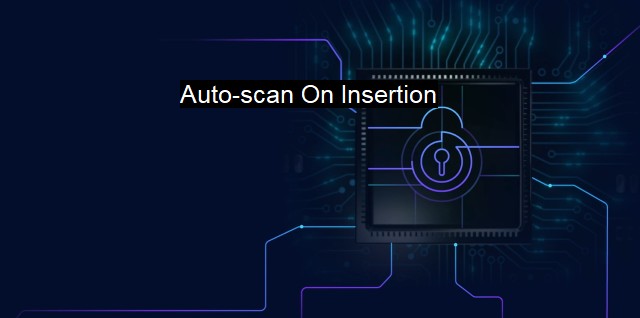What is Auto-scan On Insertion?
The Power of Auto-Scan: Protecting Against Malicious Attacks Through Insertable Devices in Cybersecurity
Auto-scan on insertion is a vital security feature designed to enhance the efficiency of threat detection in cybersecurity. It's a feature that usually comes with standard antivirus software, essentially providing real-time protection against potential threats to your computer system. Protecting digital systems from cybercrime is one of the top concerns in today's technology-driven world, and various mechanisms such as firewalls, antivirus applications, and other software security solutions have emerged to counter these threats. Among these solutions, auto-scan on insertion stands out as a highly proactive and useful attribute of many antivirus applications.The process of auto-scan on insertion, as the name suggests, automatically scans inserted external storage devices, such as USB drives or SD cards. Its primary purpose is to detect potential malware, viruses, or other security threats that might be trying to gain unauthorized access to your system. It allows for an immediate identification and management of any possible threats, largely eliminating the risk they might pose on your system. This capability to instantly scan an inserted disk for threats without manual intervention confers significant value, further reinforcing the importance of antivirus software.
This distinct feature essentially scans, identifies, and neutralizes harmful files or threats in real-time. Accordingly, it bolsters a system’s defense by ensuring any potentially harmful programs contained in the external drives are segmented and addressed before they can infiltrate or compromise the system.
The mechanism behind the function is rather simple. Every time a new device is connected to your system while the antivirus with this feature is active, a real-time alert is triggered in the antivirus software. Consequently, it runs a thorough scan on the entirety of the external device to detect any anomalies, suspicious files, or potential threats. If such exist, users are promptly alerted, leaving them the choice to either disregard the threat, delete the harmful file, or to quarantine it.
One significant advantage of the auto-scan on insertion feature is that it reduces virus incident response time, thereby lessening the risk of virus propagation within the system. As soon as a threat is identified, the feature allows the user to act instantaneously to neutralize it. There is, therefore, a reduced chance of data being compromised, borne from this fast, efficient, and automatic process. since it's an automated process, it eradicates the possibility of human error that might result from forgetting to manually initiate scans of newly inserted disks.
From a larger perspective, implementing the auto-scan on insertion function in conjunction with other security provisions contributes to a secured digital environment. In an era where cyber threats are continuously evolving, employing such proactivity through auto-scan on insertion integrated within antivirus applications is becoming more significant.
This practice is particularly important for organizations with private, operational data at stake. A single malicious file infiltrating a communal computer network can have repercussions far across its terminals. In response to this significant organizational risk, dedicating antivirus applications featuring auto-scan play an integral role in system protection.
The auto-scan on insertion feature is an excellent tool in the arsenal combating cybersecurity threats. It embodies an automated, effective, time-efficient, and user-friendly solution to the pervasive issue of malware and other viruses potentially entrenched on external devices. Through automatic scanning, threat detection preempting human error, and providing instant response, auto-scan upon insertion proves to be an essential security feature in antivirus in both personal and professional cybersecurity contexts.

Auto-scan On Insertion FAQs
What is auto-scan on insertion?
Auto-scan on insertion is a feature of cybersecurity and antivirus software that automatically scans any device or external storage media that is connected to a computer as soon as it is inserted.Why is auto-scan on insertion important?
Auto-scan on insertion is important because it helps to prevent the spread of malware and other malicious software through external storage media. By scanning these devices automatically, antivirus software can detect and remove any viruses or other threats before they can infect the computer or network.Can auto-scan on insertion slow down my computer?
Auto-scan on insertion can potentially slow down your computer, especially if you are using an older or less powerful machine. However, most modern antivirus software is designed to run these scans quickly and efficiently, so the impact on your computer's performance should be minimal.How can I enable or configure auto-scan on insertion?
The process for enabling or configuring auto-scan on insertion will vary depending on the specific antivirus software that you are using. However, most programs will have an option to enable this feature in the settings or preferences menu. You may also be able to customize the settings for the auto-scan, such as specifying which types of devices should be scanned automatically and what actions should be taken if a threat is detected. Consult the user manual or online documentation for your antivirus software for more information.| | A | | | B | | | C | | | D | | | E | | | F | | | G | | | H | | | I | | | J | | | K | | | L | | | M | |
| | N | | | O | | | P | | | Q | | | R | | | S | | | T | | | U | | | V | | | W | | | X | | | Y | | | Z | |
| | 1 | | | 2 | | | 3 | | | 4 | | | 7 | | | 8 | | |||||||